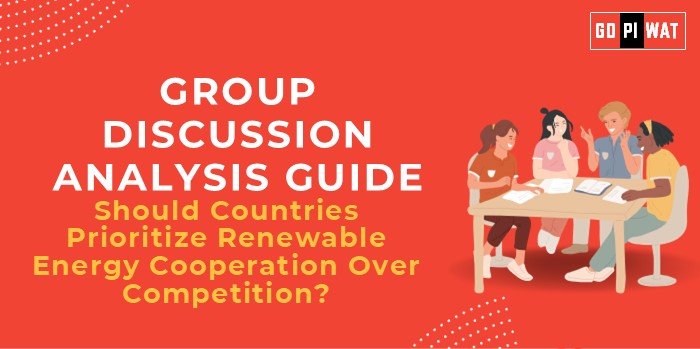📋 Group Discussion Analysis Guide: Should Countries Prioritize Renewable Energy Cooperation Over Competition?
🌐 Introduction to the Topic
- 📌 Opening Context: With global warming intensifying and energy security becoming a critical concern, nations face a pivotal choice: collaborate on renewable energy advancements or compete for technological and economic dominance. This debate highlights the broader implications for sustainable development and geopolitical stability.
- 📖 Topic Background: The transition to renewable energy is essential to mitigate climate change. Key international agreements, such as the Paris Accord, emphasize collaborative efforts to reduce carbon footprints. However, technological and economic gains in renewable energy are fueling competition among nations.
📊 Quick Facts and Key Statistics
🌍 Renewable Energy Market Growth: Expected CAGR of 8.4% from 2023 to 2030 (IEA).
💰 Global Renewable Energy Investment: Surpassed $500 billion in 2023.
🌱 Carbon Emissions Targets: Over 50 nations pledged net-zero by 2050 under the Paris Accord.
👷 Energy Transition Jobs: 12 million jobs globally in 2023, with a 7% annual growth (IRENA).
💰 Global Renewable Energy Investment: Surpassed $500 billion in 2023.
🌱 Carbon Emissions Targets: Over 50 nations pledged net-zero by 2050 under the Paris Accord.
👷 Energy Transition Jobs: 12 million jobs globally in 2023, with a 7% annual growth (IRENA).
👥 Stakeholders and Their Roles
- 🏛️ Governments: Drive policy frameworks and provide subsidies for R&D in renewables.
- 📈 Private Sector: Innovates and scales renewable technologies for mass adoption.
- 🌍 International Organizations: Entities like IRENA and the UN facilitate cooperation and share best practices.
- 🌱 Citizens and Activists: Push for accountability and adoption of sustainable practices.
🏆 Achievements and Challenges
✨ Achievements:
- 🌍 Global Collaboration: Initiatives like the International Solar Alliance (ISA) promote shared benefits.
- 📜 Technology Transfer: Collaborative projects, such as wind farms co-developed by Denmark and India, showcase success.
- ⚡ Energy Security: Diversifying energy sources reduces dependency on fossil fuel imports.
- 📈 Economic Opportunities: Joint ventures create cross-border employment and economic benefits.
⚠️ Challenges:
- 📉 Technological Competition: Countries like the US and China race to dominate solar and wind technology.
- ⚖️ Policy Divergences: National priorities often hinder cohesive international agreements.
- 🌍 Resource Inequalities: Developing nations face difficulty accessing advanced technologies.
🌍 Global Comparisons:
- ✔️ Success: Scandinavian nations collaborate on wind power through shared grids.
- ❌ Challenges: US-China rivalry limits potential for cooperative breakthroughs in solar technology.
📢 Structured Arguments for Discussion
- ✅ Supporting Stance: “Renewable energy cooperation enables cost sharing, rapid technology dissemination, and unified climate action.”
- ❌ Opposing Stance: “Competition fosters innovation and accelerates breakthroughs, giving countries strategic advantages.”
- ⚖️ Balanced Perspective: “A hybrid model balancing competition with strategic partnerships can optimize renewable energy advancement.”
🧠 Effective Discussion Approaches
- 🎯 Opening Approaches:
- “The $500 billion global investment in renewables reflects unprecedented opportunities for collaboration.”
- “The US-China solar technology race exemplifies how competition can hinder collective progress.”
- 🤝 Counter-Argument Handling:
- Rebut competition-focused arguments by highlighting shared costs and risk reduction in cooperation.
- Emphasize successful models like the European Union’s renewable grid integration.
📊 Strategic Analysis of Strengths and Weaknesses
- 🌟 Strengths: Cost sharing, global knowledge exchange, and diversified energy grids.
- ⚠️ Weaknesses: Geopolitical tensions, intellectual property conflicts.
- 📈 Opportunities: Emerging markets, joint R&D programs.
- ⚡ Threats: Trade wars, resource scarcity.
🎓 Connecting with B-School Applications
- 💼 Real-World Applications: Renewable energy policies intersect with finance (green bonds), operations (smart grids), and development (rural electrification).
- 📚 Sample Interview Questions:
- “How can cross-border cooperation accelerate energy transitions?”
- “What role do international organizations play in renewable energy innovation?”
- 💡 Insights for B-School Students:
- Policy advocacy can unlock opportunities for green entrepreneurship.
- Collaborative models offer frameworks for multinational project management.


